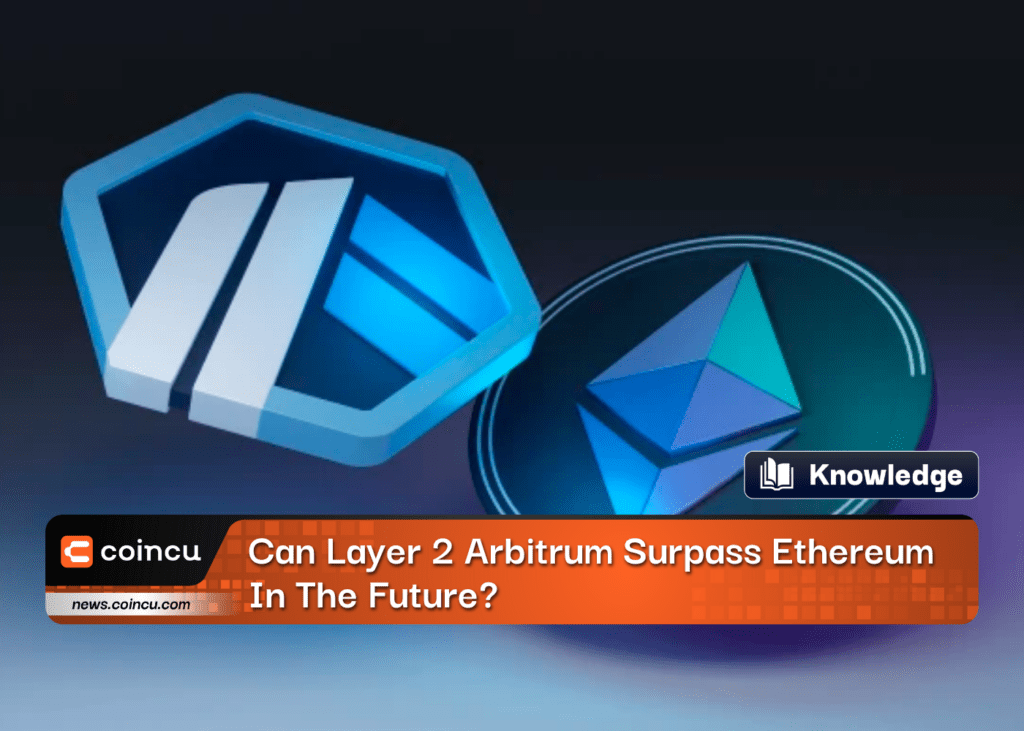Key Points:
- With its Optimistic rollup technology, Arbitrum is gradually asserting its position as the top layer 2.
- Ethereum still has many issues to improve, such as transaction fees, and scalability, but its ecosystem has grown diverse.
- To replace Ethereum is impossible with a layer 2 solution like Arbitrum.
Almost everyone in the crypto community is aware of Ethereum’s scalability concerns, and hefty transaction costs these days. Unfortunately, Ethereum is also sluggish and costly to use, and this will continue until people migrate to another blockchain (such as Solana, Fantom, or Avalanche) or until planned Ethereum updates speed things up in the coming years. At this time, Arbitrum has spoken to become the current Ethereum Layer 2 leader.

Current situation
ETH 2.0 is the critical road ahead for Ethereum’s existence. Since deciding on sharding, the ETH team has been working hard to ensure that both this and the transition to Proof-of-Stake proceed as easily as possible.
According to the State of the dApps, Ethereum has witnessed enormous growth this year, with the network now supporting over 2,000 decentralized apps (dApps), including decentralized finance (DeFi), non-fungible tokens (NFTs), gaming, and more.
The number of Ethereum users has also increased dramatically. According to DefiLlama, there are currently 38 million Ethereum addresses engaging with DeFi protocols, with over $68 billion in total wealth locked in DeFi protocols.
Yet, Ethereum’s growing ecosystem and popularity have led to increase transaction costs and fears that scalability difficulties have rendered Ethereum prohibitively expensive for average consumers.
Despite the emergence of alternative blockchains such as Binance Smart Chain, Solana, Cardano, and Polkadot, Ethereum remains the leading smart contract platform because of its network impact and technological investment by projects and developers.
As the rest of the world waits, a third answer has emerged: scaling solutions. To speed things up, these are bits of software that sit above the fundamental layer of a blockchain, in this instance, Ethereum. Arbitrum is one such scaling option, and it has grown in popularity as a place for Ethereum users to finish their transactions.
Arbitrum intends to airdrop its new ARB token on March 23, 2023, enabling holders to vote on protocol decisions. Arbitrum is completing its long-awaited move to a DAO (decentralized autonomous organization).
What Is Arbitrum?
Arbitrum is a layer 2 solution aimed to enhance Ethereum smart contracts’ performance and scalability while also introducing extra security measures.
The platform is intended to enable developers to simply execute unmodified EVM contracts and Ethereum transactions on layer 2 while still reaping the benefits of Ethereum’s superb layer 1 security.
Arbitrum uses the transaction aggregation approach to capture batches of transmitted transactions on the Ethereum main chain and execute them on inexpensive, scalable layer 2 sidechains while utilizing Ethereum to assure accuracy. This approach offloads the majority of the computational and storage burden that Ethereum now carries, allowing layer 2-based dApps to thrive.
Arbitrum’s mechanism
Optimistic Rollups
The number of rounds of disputes necessary to resolve challenges is one method to identify one form of rollup from another. The Multi-Round Interactive Optimistic Rollup is used in Arbitrum’s version. An on-chain contract arbitrates the dispute between the challenger and the asserter. Also, the quantity of data on-chain is small.
EVM-Compatible and Ease of Use
Arbitrum’s excellent interoperability with the Ethereum Virtual Machine (EVM) is another advantage. In a word, the EVM is the “supercomputer” that operates the Ethereum network for the execution of smart contracts. Arbitrum features its own “supercomputer,” known as the Arbitrum Virtual Machine (AVM), which powers everything in the system.
The EVM architecture is supported by the AVM. This implies that ETH developers may build on Arbitrum in the same way that they would on the Ethereum network.
Arbitrum vs. Ethereum
A slew of scaling solutions is being developed, with the primary objective of increasing transaction speed and throughput without jeopardizing decentralization or security. ETH 2.0, a multi-year, multi-phase upgrade plan that involves Ethereum’s shift to a proof-of-stake network and shard chains, aims to make Ethereum more scalable, secure, and sustainable. Yet, Ethereum application base-layer scalability is still years away.
Layer-2 initiatives are solutions aimed at expanding Ethereum by managing transactions off the mainnet while relying on Ethereum’s decentralized consensus mechanism for security. Rollups, a Layer-2 solution, are intended to decongest the Ethereum network by grouping (or “rolling up”) transactions, compressing and processing them off-chain before sending the results back to Ethereum, resulting in increased speed and drastically cheaper transaction fees.
Rollups are classified into two types: Optimistic rollups, which assume transactions are valid and only execute the computation if a fraudulent transaction is suspected, and Zero-knowledge rollups, which bundle the transactions for off-chain processing and submit a validity proof to the Ethereum network verifying the transactions’ validity. It is expected that optimistic rollups may boost scalability by 10 to 100 times, depending on the transaction.
With that in mind, we can plainly understand Arbitrum’s distinct advantage, a layer-2 optimistic rollup solution developed on Ethereum by Off-chain Laboratories. It is now the most used layer-2 protocol.
Arbitrum, according to blockchain analytics platform Nansen, will lead the wave of Ethereum scalability solutions in the near future, with developers building on it.
Arbitrum supports 40,000 transactions per second (TPS), which is much more than Ethereum’s 15 to 30 TPS. Arbitrum transaction costs are now nearly three times cheaper than Ethereum base layer fees ($0.12 on Arbitrum One vs. $2.03 on Ethereum as of posting time, according to L2 pricing).
Users are flocking to Arbitrum while utilizing dApps on Ethereum that need transactions, such as Aave and Uniswap, because of the decreased transaction fees. This might be accomplished by incorporating the Arbitrum One network extension into the MetaMask wallet. Arbitrum is now supported by centralized cryptocurrency exchanges like Binance and Crypto.com.
Arbitrum currently handles Ethereum transactions using an optimistic rollup mechanism and settles them on a sidechain before reporting back to Ethereum.
According to Ethereum founder Buterin, optimistic rollups may be favored in the medium run since they are simpler and easier to implement. Nonetheless, despite their complexity, ZK rollups may be a preferable technological solution in the long run due to their quicker finality time and higher security.
One thing that shows the size of Arbitrum is still quite a lot to consider when its level of support for DeFi platforms as well as NFT, is not comparable to Ethereum.
Projections to the future
Saying that so that we can clearly see that Arbitrum cannot completely replace Ethereum because it is only a solution to help ETH achieve its goal. In addition to the Optimistic rollup, there is also the ZK rollup, proving that Arbitrum will not dominate its position if layer 2 platforms like Polygon continue to upgrade.
Other L1s, such as Solana and Avalanche, may have a head start with quicker transaction speeds and lower costs, but are they as safe as Ethereum? They, too, are going through growing pains, as seen by Solana’s on-and-off outages in recent months. There are too many fresh things to say about layer 2, like Arbitrum, but really dominating the market like Ethereum is tough.
DISCLAIMER: The Information on this website is provided as general market commentary and does not constitute investment advice. We encourage you to do your own research before investing.
Join us to keep track of news: https://linktr.ee/coincu
Harold
Coincu News





